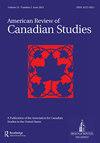The Heart of Toronto: Corporate Power, Civic Activism, and the Remaking of Downtown Yonge Street
IF 0.4
Q3 AREA STUDIES
引用次数: 1
Abstract
culturally in Europe and North America” (78). Recommendations about masking changed, creating an opening for dissenters to claim that the science was wrong, or at least uncertain. Not wearing a mask became a political statement in some parts of the world. Duffin provides a short history of quarantine before moving on to the issue of lockdowns. Throughout the book, she does an excellent job of briefly pointing out the different approaches taken in different countries, noting how “Lessons from the pandemic kept coming” (86). When she turns her attention to “the tangled weeds of therapeutics” (106), moving quickly through various treatments, Duffin’s clinical knowledge is on full display. She describes the necessary interventions such as intubations and takes us through the story of treatments. She provides enough detail for a non-clinician to understand each one, while showing the clinical consequences of public debate. For example, following U.S. President Donald Trump’s endorsement of hydroxychloroquine in March 2020, shortages were reported and this had consequences for people with lupus or arthritis, who use the drug to alleviate their symptoms. Concurrent with the push for therapeutics was the development of vaccines, which is described as “a remarkable scientific success story” (111). Duffin estimates that 55 vaccines were in development and some, such as the mRNA vaccines developed by Pfizer-BioNTech and Moderna, were entirely novel. In the space of a few short months, vaccines were available in some countries. In the final section of the book, Duffin uses selective examples to provide an analysis of subsequent-wave infections and new variants. The book ends with the rapid spread of omicron. As the case numbers piled up, the system of tracking and testing strained under the weight of this variant. The response to omicron was, to say the least, not as robust as in the initial wave of the pandemic. China, which continued its policy of firm lockdowns, was the exception. Elsewhere, mask restrictions were lifted, initially for people who were vaccinated, and then for everyone. Businesses re-opened and people were told that they had to learn to “live with COVID-19 and learn to accept a few deaths” (193). The pandemic is, of course, not over. Declarations to the contrary reflect the perspective that COVID-19 could be controlled, even if there was an ongoing social cost. Although there will be other histories of the pandemic, I am confident that Duffin’s analysis will occupy an important place in the historiography of COVID-19 for years to come.多伦多市中心:企业权力、公民行动主义和市中心央街的重建
欧洲和北美的文化差异”(78)。关于掩盖的建议改变了,这给反对者提供了一个机会,声称科学是错误的,或者至少是不确定的。在世界上的一些地方,不戴口罩成为一种政治声明。在谈到封锁问题之前,达芬简要介绍了隔离的历史。在整本书中,她出色地简要指出了不同国家采取的不同方法,并指出“大流行的教训是如何不断出现的”(86)。当她将注意力转向“治疗学中纠结的杂草”(106页),快速地浏览各种治疗方法时,Duffin的临床知识得到了充分的展示。她描述了必要的干预措施,如插管,并向我们讲述了治疗的故事。她为非临床医生提供了足够的细节来理解每一个,同时展示了公众辩论的临床后果。例如,在美国总统唐纳德·特朗普于2020年3月批准羟氯喹之后,有报道称羟氯喹短缺,这对狼疮或关节炎患者产生了影响,他们使用这种药物来缓解症状。在推动治疗方法的同时,疫苗的发展被描述为“一个非凡的科学成功故事”(111)。Duffin估计有55种疫苗正在开发中,其中一些疫苗,如辉瑞- biontech和Moderna开发的mRNA疫苗,是完全新颖的。在短短几个月的时间里,一些国家就有了疫苗。在书的最后一部分,Duffin使用了一些有选择的例子来分析后续感染和新的变种。这本书以欧米克隆的迅速传播结尾。随着病例数量的增加,追踪和检测系统在这种变体的重压下变得紧张起来。至少可以说,对omicron的反应不像大流行的最初一波那样强劲。继续实行严格封锁政策的中国是个例外。在其他地方,口罩限制被取消,最初是针对接种疫苗的人,然后是针对所有人。企业重新开业,人们被告知,他们必须学会“与COVID-19共存,学会接受一些死亡”(193)。当然,大流行还没有结束。与此相反的宣言反映了一种观点,即即使有持续的社会成本,COVID-19也可以得到控制。尽管还有其他关于这场大流行的历史,但我相信,在未来几年里,达芬的分析将在COVID-19的历史编纂中占据重要地位。
本文章由计算机程序翻译,如有差异,请以英文原文为准。
求助全文
约1分钟内获得全文
求助全文
来源期刊

American Review of Canadian Studies
AREA STUDIES-
CiteScore
0.60
自引率
0.00%
发文量
25
期刊介绍:
American Nineteenth Century History is a peer-reviewed, transatlantic journal devoted to the history of the United States during the long nineteenth century. It welcomes contributions on themes and topics relating to America in this period: slavery, race and ethnicity, the Civil War and Reconstruction, military history, American nationalism, urban history, immigration and ethnicity, western history, the history of women, gender studies, African Americans and Native Americans, cultural studies and comparative pieces. In addition to articles based on original research, historiographical pieces, reassessments of historical controversies, and reappraisals of prominent events or individuals are welcome. Special issues devoted to a particular theme or topic will also be considered.
 求助内容:
求助内容: 应助结果提醒方式:
应助结果提醒方式:


